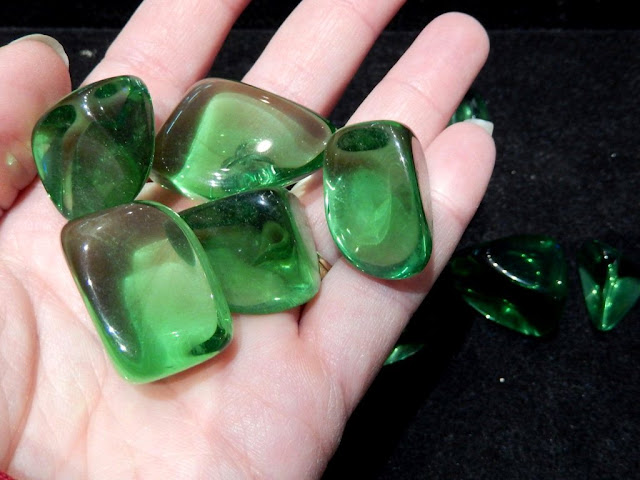World’s Most Amazing Gemstone Found in Volcano
 |
| Helenite is a man-made glass made from the fused volcanic rock dust from Mount St. |
Helenite is a man-made glass made from the fused volcanic rock dust from Mount St. Helens and marketed as a gemstone. Helenite was first created accidentally after the eruption of Mount St. Helens in 1980.
It is sold as facet rough, faceted stones, tumbled stones, and mounted in finished jewelry. The material has been produced in a variety of green, red, and blue hues, which are produced or enhanced by adding coloring agents to the melt. Tourists visiting Mount St. Helens are the primary market for the novelty colored stone jewelry made with helenite.
The story of helenite begins shortly after the May 18, 1980 volcanic eruption of Mount St. Helens that blanketed portions of the northwestern United States with a thin layer of volcanic ash. The eruption was widely described in the media, and millions of people became curious about the volcano and the impact of the eruption.
Immediately after the eruption, people who lived near the volcano began sharing samples of the ash with curious friends and relatives. People who lived outside of the eruption area began travelling to the impact area to witness the destruction. Many of them carried home a small amount of ash to show to friends and neighbors. The ash quickly became a souvenir.
A few days after the eruption, workers using an acetylene torch while doing salvage work accidentally discovered that the torch could melt the volcanic ash into a green glass. This story was circulated, and experiments determined that a transparent to translucent green glass could be reproduced in a laboratory by heating samples of ash to 2700 degrees Fahrenheit in a high-temperature furnace followed by rapid cooling.
A few people began producing the glass, cutting it into faceted stones, mounting them in jewelry, and selling the items to tourists. Less than one year after the eruption, Dharma Trading Company began using the name “Helenite” in commerce and filed a trademark with the United States Patent and Trademark Office.
Their trademark was filed to reserve the name “Helenite” for their exclusive use in marketing “glass in the nature of cut gems and rough gems made from volcanic ash from Mount St. Helens, for use in making jewelry.”
| Faceted red helenite |
Helenite is a man-made material with properties similar to obsidian. This similarity has led to “Mount St. Helens obsidian,” “emerald obsidianite,” “ruby obsidianite,” and a number of other similar terms being used for the material.
. The ash has a basic composition that is similar to the igneous rock known as dacite. It consists of approximately 65% SiO2, 18% Al2O3, 5% Fe2O3, 4% CaO, 4% Na2O, and 2% MgO. Numerous trace and minor elements also occur in the ash.
The stone has been marketed by the jewelry industry because of its emerald-like color, good refractive index, and durability. It is seen as an inexpensive alternative to naturally occurring green gemstones like emerald and peridot. Helenite can also come in various red, green and blue varieties.
References:
- Chemical Composition of Mount St. Helens Volcanic Ash: H.E. Taylor and F.E. Lichte; Geophysical Research Letters, Volume 7, Issue 11, Pages 949-952, November 1980.
- All About Jewels: Illustrated Dictionary of Jewelry
- Geology.com Gemstones – Helenite